Assessment of Water Resource Sustainability and Glacier Runoff Impact on the Northern and Southern Slopes of the Tianshan Mountains
Abstract
1. Introduction
2. Setting and Methods
2.1. Study Area
2.2. The Available Freshwater Resources
2.3. Runoff Simulation
2.4. Water Consumption in the Socioeconomic System
2.4.1. Agricultural Water
2.4.2. Industrial Water
2.4.3. Domestic Water
2.4.4. Ecological Water
2.4.5. Estimation of Future Water Requirements
- (1)
- Traditional Development Mode
- (2)
- Economic Growth Mode
- (3)
- Water-Saving Mode
2.5. Sources and Preprocessing of Socioeconomic Data
2.6. Evaluation of Water Sustainability
3. Results
3.1. Interannual Variations in Available Freshwater Resources
3.2. Current Variations in Water Withdrawal
3.3. Future Variations in Water Withdrawal
3.4. Variations in Water Stress Levels
3.4.1. Water Stress Levels in the MnsRB
3.4.2. Water Stress Levels in the MztRB
4. Discussion
5. Conclusions
Author Contributions
Funding
Institutional Review Board Statement
Informed Consent Statement
Data Availability Statement
Conflicts of Interest
Abbreviations
| SDGs | Sustainable Development Goals |
| MnsRB | Manas River Basin |
| MztRB | Muzati River Basin |
| LWS | Level of Water Stress |
| VIC-CAS | Variable Infiltration Capacity Chinese Academy of Sciences |
| SSPs | Shared Socioeconomic Pathways |
| GCM | Global Climate Models |
| QDM | Quantile Delta Mapping |
| AWD | Agricultural Water Demand |
| IWD | Industrial Water Demand |
| DWD | Domestic Water Demand |
| EWD | Ecological Water Demand |
| TWW | Total Water Withdrawal |
References
- Bakker, K. Water security: Research challenges and opportunities. Science 2012, 337, 914–915. [Google Scholar] [CrossRef] [PubMed]
- Florke, M.; Schneider, C.; McDonald, R.I. Water Competition between Cities and Agriculture Driven by Climate Change and Urban Growth. Nat. Sustain. 2018, 1, 51–58. [Google Scholar] [CrossRef]
- WWAP/UN-WATER. The United Nations World Water Development Report 2024: Water for Prosperity and Peace; UNESCO: Paris, France, 2024. [Google Scholar]
- Mekonnen, M.M.; Hoekstra, A.Y. Four billion people facing severe water scarcity. Sci. Adv. 2016, 2, e1500323. [Google Scholar] [CrossRef]
- Vörösmarty, C.J.; McIntyre, P.B.; Gessner, M.O.; Dudgeon, D.; Prusevich, A.; Green, P.; Glidden, S.; Bunn, S.E.; Sullivan, C.A.; Liermann, C.R.; et al. Erratum: Global Threats to Human Water Security and River Biodiversity. Nature 2010, 467, 555–561. [Google Scholar] [CrossRef] [PubMed]
- Greve, P.; Kahil, T.; Mochizuki, J.; Schinko, T.; Satoh, Y.; Burek, P.; Fischer, G.; Tramberend, S.; Burtscher, R.; Langan, S.; et al. Global Assessment of Water Challenges under Uncertainty in Water Scarcity Projections. Nat. Sustain. 2018, 1, 486–494. [Google Scholar] [CrossRef]
- Qin, Y.; Abatzoglou, J.T.; Siebert, S.; Huning, L.S.; AghaKouchak, A.; Mankin, J.S.; Hong, C.P.; Tong, D.; Davis, S.J.; Mueller, N.D. Agricultural Risks from Changing Snowmelt. Nat. Clim. Change 2020, 10, 459–465. [Google Scholar] [CrossRef]
- Wu, K.P.; Liu, S.Y.; Jiang, Z.L.; Zhu, Y.; Wei, J.F.; Tahir, A.A. Spatiotemporal Pattern of Glacier Mass Balance in the Tibetan Plateau Interior Area over the Past 40 Years. J. Hydrol. 2024, 635, 131200. [Google Scholar] [CrossRef]
- Mingle, J. IPCC Special Report on the Ocean and Cryosphere in a Changing Climate. New York Rev. Books 2020, 67, 49–51. [Google Scholar]
- Fan, Y.F.; Tong, L.Y.; Ji, Q. Variations in Glacial Area in the Middle Himalayas over the Past 30 Years. Prog. Phys. Geogr.-Earth Environ. 2025, 49, 24–43. [Google Scholar] [CrossRef]
- de Kok, R.J.; Kraaijenbrink, P.D.A.; Tuinenburg, O.A.; Bonekamp, P.N.J.; Immerzeel, W.W. Towards Understanding the Pattern of Glacier Mass Balances in High Mountain Asia Using Regional Climatic Modelling. Cryosphere 2020, 14, 3215–3234. [Google Scholar] [CrossRef]
- Huss, M.; Hock, R. Global-Scale Hydrological Response to Future Glacier Mass Loss. Nat. Clim. Change 2018, 8, 135–140. [Google Scholar] [CrossRef]
- Kaser, G.; Grosshauser, M.; Marzeion, B. Contribution Potential of Glaciers to Water Availability in Different Climate Regimes. Proc. Natl. Acad. Sci. USA 2010, 107, 20223–20227. [Google Scholar] [CrossRef]
- Peng, Y.Z.; Zhang, H.; Zhang, Z.; Tang, B.; Shen, D.D.; Yin, G.; Li, Y.M.; Chen, X.; Hu, Z.Y.; Nazrollozoda, S.H. Future Challenges of Terrestrial Water Storage over the Arid Regions of Central Asia. Int. J. Appl. Earth Obs. Geoinf. 2024, 132, 104026. [Google Scholar] [CrossRef]
- Pritchard, H.D. Asia’s Shrinking Glaciers Protect Large Populations from Drought Stress. Nature 2019, 569, 649–654. [Google Scholar] [CrossRef] [PubMed]
- Gharib, A.A.; Blumberg, J.; Manning, D.T.; Goemans, C.; Arabi, M. Assessment of Vulnerability to Water Shortage in Semi-Arid River Basins: The Value of Demand Reduction and Storage Capacity. Sci. Total Environ. 2023, 871, 161964. [Google Scholar] [CrossRef]
- Wang, S.; Zhao, Q.; Pu, T. Assessment of Water Stress Level about Global Glacier-Covered Arid Areas: A Case Study in the Shule River Basin, Northwestern China. J. Hydrol. Reg. Stud. 2021, 37, 100895. [Google Scholar] [CrossRef]
- Plum, A.; Kaljee, L. Achieving Sustainable, Community-Based Health in Detroit Through Adaptation of the UNSDGs. Ann. Glob. Health 2016, 82, 981–990. [Google Scholar] [CrossRef]
- FAO and UN-Water. 2018 Progress on Level of Water Stress. Global Baseline for SDG 6 Indicator 6.4.2: Level of Water Stress: Freshwater Withdrawal as a Proportion of Available Freshwater Resources. Available online: https://www.unwater.org/sites/default/files/app/uploads/2018/08/642-progress-on-level-of-water-stress-2018.pdf (accessed on 15 June 2022).
- Vanham, D.; Hoekstra, A.Y.; Wada, Y.; Bouraoui, F.; de Roo, A.; Mekonnen, M.M.; van de Bund, W.J.; Batelaan, O.; Pavelic, P.; Bastiaanssen, W.G.M.; et al. Physical Water Scarcity Metrics for Monitoring Progress towards SDG Target 6.4: An Evaluation of Indicator 6.4.2 “Level of Water Stress”. Sci. Total Environ. 2018, 613–614, 218–232. [Google Scholar] [CrossRef]
- Ievoli, R.; Vinciguerra, R.; Bruno, A. Investigating Water Sustainability towards Indicators: An Empirical Illustration Using Country-Level Data. Socioecon. Plann. Sci. 2024, 96, 102102. [Google Scholar] [CrossRef]
- Jia, Y.; Li, Z.; Gao, H.; Wang, S.; Sun, M.; Wang, P. Hydrological Response to Climate Change in a Glacierized Catchment in Eastern Tien Shan, Central Asia. J. Hydrol. Reg. Stud. 2024, 51, 101669. [Google Scholar] [CrossRef]
- Chen, Y.N.; Li, W.H.; Deng, H.J.; Fang, G.H.; Li, Z. Changes in Central Asia’s Water Tower: Past, Present and Future. Sci. Rep. 2016, 6, 39364. [Google Scholar] [CrossRef] [PubMed]
- Sorg, A.; Bolch, T.; Stoffel, M.; Solomina, O.; Beniston, M. Climate Change Impacts on Glaciers and Runoff in Tien Shan (Central Asia). Nat. Clim. Change 2012, 2, 725–731. [Google Scholar] [CrossRef]
- Fang, G.; Chen, Y.; Li, Z. Variation in Agricultural Water Demand and Its Attributions in the Arid Tarim River Basin. J. Agric. Sci. 2018, 156, 301–311. [Google Scholar] [CrossRef]
- Liu, W.; Tian, H.; Xu, X.; Yang, G. Evaluation of Water Supply Function in the Economic Belt of the Northern Slope of the Tianshan Mountains Based on the InVEST Model. Clim. Serv. 2024, 36, 100519. [Google Scholar] [CrossRef]
- Tang, Q.; Liu, X.; Zhou, Y.; Wang, P.; Li, Z.; Hao, Z.; Liu, S.; Zhao, G.; Zhu, B.; He, X.; et al. Climate Change and Water Security in the Northern Slope of the Tianshan Mountains. Geogr. Sustain. 2022, 3, 246–257. [Google Scholar] [CrossRef]
- Zhang, P.; Chen, X.; Bao, A.; Liu, T.; Ndayisaba, F. Assessing Spatio-Temporal Characteristics of Water Storage Changes in the Mountainous Areas of Central Asia Based on GRACE. Chin. Geogr. Sci. 2017, 27, 918–933. [Google Scholar] [CrossRef]
- Yang, P.; Zhang, S.; Xia, J.; Chen, Y.; Zhang, Y.; Cai, W.; Wang, W.; Wang, H.; Luo, X.; Chen, X. Risk Assessment of Water Resource Shortages in the Aksu River Basin of Northwest China under Climate Change. J. Environ. Manag. 2022, 305, 114394. [Google Scholar] [CrossRef]
- Tang, X.L.; Xu, L.P.; Zhang, Z.Y.; Lv, X. Effects of Glacier Melting on Socioeconomic Development in the Manas River Basin, China. Nat. Hazards 2013, 66, 533–544. [Google Scholar] [CrossRef]
- Luo, Y.; Arnold, J.; Allen, P.; Chen, X. Baseflow Simulation Using SWAT Model in an Inland River Basin in Tianshan Mountains, Northwest China. Hydrol. Earth Syst. Sci. 2012, 16, 1259–1267. [Google Scholar] [CrossRef]
- Zhao, Q.; Zhao, C.; Qin, Y. Response of the hydrological processes to climate change in the Muzati River basin with high glacierization, southern slope of the Tianshan Mountains. J. Glaciol. Geocryol. 2020, 42, 1285–1298. (In Chinese) [Google Scholar]
- Jin, Z.Z.; Zhao, Q.D.; Qin, X.; Zhang, J.T.; Zhang, H.; Qin, J.; Qin, Y.; Li, H.Y.; Chen, J.Z.; Liu, Y.S.; et al. Quantifying the Impact of Landscape Changes on Hydrological Variables in the Alpine and Cold Region Using Hydrological Model and Remote Sensing Data. Hydrol. Process 2021, 35, 14392. [Google Scholar] [CrossRef]
- Wang, F.; Tian, D. On Deep Learning-Based Bias Correction and Downscaling of Multiple Climate Models Simulations. Clim. Dyn. 2022, 59, 3451–3468. [Google Scholar] [CrossRef]
- Cannon, A.J.; Sobie, S.R.; Murdock, T.Q. Bias Correction of GCM Precipitation by Quantile Mapping: How Well Do Methods Preserve Changes in Quantiles and Extremes? J. Clim. 2015, 28, 6938–6959. [Google Scholar] [CrossRef]
- He, Q.S.; Yang, J.P.; Zhao, Q.D.; Wang, Y.X.; Chen, H.J.; Ji, Q. Variations of Glacier Hydrological Regulation in the North- and South-Facing Slopes of Tianshan Mountains, China: Past and Future. J. Hydrol.-Reg. Stud. 2022, 43, 101199. [Google Scholar] [CrossRef]
- Ye, Z.X.; Chen, Y.N.; Li, W.H. Ecological Water Rights and Water-Resource Exploitation in the Three Headwaters of the Tarim River. Quat. Int. 2014, 336, 20–25. [Google Scholar] [CrossRef]
- Wang, R.; Lu, X.; Song, Y.; Fan, Z.; Ma, Y. Patterns and Characteristics of Ecological Water Demand in West Arid Zone of China—A Case Study of Green Corridor in the Lower Reaches of Tarim River. Ying Yong Sheng Tai Xue Bao 2003, 14, 520–524. [Google Scholar]
- Yang, Y.N.; Chen, X.F.; Jiang, Y. Estimation and Spatial-Temporal Distribution Characteristics of Ecological Water Demand for Natural Vegetation in Aksu River Irrigation Area, XinJiang, China. Water Resour. 2024, 51, 780–788. [Google Scholar] [CrossRef]
- Wang, G.X.; Cheng, G.D. Ecological water demand and its estimation in arid inland river basins: A case study of the Heihe River Basin. J. Desert Res. 2002, 2, 33–38. (In Chinese) [Google Scholar]
- Shokoohi, A.; Amini, M. Introducing a new method to determine rivers’ ecological water requirement in comparison with hydrological and hydraulic methods. Int. J. Environ. Sci. Technol. 2014, 11, 747–756. [Google Scholar] [CrossRef]
- Amrit, K.; Mishra, S.K.; Pandey, R.P.; Himanshu, S.K.; Singh, S. Standardized precipitation index-based approach to predict environmental flow condition. Ecohydrology 2019, 12, e2127. [Google Scholar] [CrossRef]
- Kormos, P.R.; Luce, C.H.; Wenger, S.J.; Berghuijs, W.R. Trends and Sensitivities of Low Streamflow Extremes to Discharge Timing and Magnitude in Pacific Northwest Mountain Streams. Water Resour. Res. 2016, 52, 4990–5007. [Google Scholar] [CrossRef]
- Hou, S.W. Analysis of ecological base flow in Dawenhe River based on various hydrological methods. Hydrology 2015, 35, 61–66. (In Chinese) [Google Scholar]
- Tian, S.S. Comprehensive Evaluation and Simulation of Water Resources Carrying Capacity in the Tarim Basin. Ph.D. Thesis, East China Normal University, Shanghai, China, 2022. (In Chinese). [Google Scholar]
- O’Neill, B.C.; Kriegler, E.; Riahi, K.; Ebi, K.L.; Hallegatte, S.; Carter, T.R.; Mathur, R.; van Vuuren, D.P. A new scenario framework for climate change research: The concept of shared socioeconomic pathways. Clim. Change 2014, 122, 387–400. [Google Scholar] [CrossRef]
- Riahi, K.; Van Vuuren, D.P.; Kriegler, E.; Edmonds, J.; O’Neill, B.C.; Fujimori, S.; Bauer, N.; Calvin, K.; Dellink, R.; Fricko, O.; et al. The Shared Socioeconomic Pathways and their energy, land use, and greenhouse gas emissions implications: An overview. Glob. Environ. Change 2017, 42, 153–168. [Google Scholar] [CrossRef]
- Chen, Y.; Guo, F.; Wang, J.; Cai, W.; Wang, C.; Wang, K. Provincial and gridded population projection for China under shared socioeconomic pathways from 2010 to 2100. Sci. Data 2020, 7, 83. [Google Scholar] [CrossRef]
- Dai, K.; Shen, S.; Cheng, C. Evaluation and analysis of the projected population of China. Sci. Rep. 2022, 12, 3644. [Google Scholar] [CrossRef]
- Huang, J.; Qin, D.; Jiang, T.; Wang, Y.; Feng, Z.; Zhai, J.; Cao, L.; Chao, Q.; Xu, X.; Wang, G.; et al. Effect of Fertility Policy Changes on the Population Structure and Economy of China: From the Perspective of the Shared Socioeconomic Pathways. Earth’s Feature 2019, 7, 250–265. [Google Scholar] [CrossRef]
- Jing, C.; Tao, H.; Jiang, T.; Wang, Y.; Zhai, J.; Cao, L.; Su, B. Population, urbanization and economic scenarios over the Belt and Road region under the Shared Socioeconomic Pathways. J. Geogr. Sci. 2020, 30, 68–84. [Google Scholar] [CrossRef]
- Deng, M.J.; Zhang, Y.; Li, X.Q. Development trend of water supply and water demand in the North of the Tianshan Mountains, Xinjiang. Arid. Land. Geogr. 2010, 33, 315–324. (In Chinese) [Google Scholar]
- Liu, X.; Tang, Q.; Zhao, Y.; Wang, P. Persistent Water Scarcity Due To High Irrigation Demand in Arid China: A Case Study in the North Slope of the Tianshan Mountains. Earths Future 2024, 12, e2024EF005070. [Google Scholar] [CrossRef]
- Liu, X.; Shen, Y.; Guo, Y.; Li, S.; Guo, B. Modeling Demand/Supply of Water Resources in the Arid Region of Northwestern China during the Late 1980s to 2010. J. Geogr. Sci. 2015, 25, 573–591. [Google Scholar] [CrossRef]
- Shen, Y.; Li, S.; Chen, Y.; Qi, Y.; Zhang, S. Estimation of Regional Irrigation Water Requirement and Water Supply Risk in the Arid Region of Northwestern China 1989-2010. Agric. Water Manag. 2013, 128, 55–64. [Google Scholar] [CrossRef]
- Zhang, L.; Ma, Q.; Zhao, Y.; Chen, H.; Hu, Y.; Ma, H. China’s strictest water policy: Reversing water use trends and alleviating waterstress. J. Environ. Manag. 2023, 345, 118867. [Google Scholar] [CrossRef] [PubMed]
- Cai, W.; Gu, X.; Du, Y.; Chang, T.; Lu, S.; Zheng, X.; Bai, D.; Song, H.; Sun, S.; Cai, H. Effects of mulching on water saving, yield increase and emission reduction for maize in China. Agric. Water Manag. 2022, 274, 107954. [Google Scholar] [CrossRef]
- Chen, Q.; Liu, X. Plastic film mulch use efficiency in agricultural production: A regional analysis in China. Environ. Dev. Sustain. 2024. [Google Scholar] [CrossRef]
- Fang, C.; Gao, Q.; Zhang, X.; Cheng, W. Spatiotemporal Characteristics of the Expansion of an Urban Agglomeration and Its Effect on the Eco-Environment: Case Study on the Northern Slope of the Tianshan Mountains. Sci. China Earth Sci. 2019, 62, 1461–1472. [Google Scholar] [CrossRef]
- Wang, X.; Yang, T.; Xu, C.-Y.; Yong, B.; Shi, P. Understanding the Discharge Regime of a Glacierized Alpine Catchment in the Tianshan Mountains Using an Improved HBV-D Hydrological Model. Glob. Planet. Change 2019, 172, 211–222. [Google Scholar] [CrossRef]
- Luo, Y.; Arnold, J.; Liu, S.; Wang, X.; Chen, X. Inclusion of Glacier Processes for Distributed Hydrological Modeling at Basin Scale with Application to a Watershed in Tianshan Mountains, Northwest China. J. Hydrol. 2013, 477, 72–85. [Google Scholar] [CrossRef]
- Sun, S.; Zhou, X.; Liu, H.; Jiang, Y.; Zhou, H.; Zhang, C.; Fu, G. Unraveling the effect of inter-basin water transfer on reducing water scarcity and its inequality in China. Water Res. 2021, 194, 116931. [Google Scholar] [CrossRef]
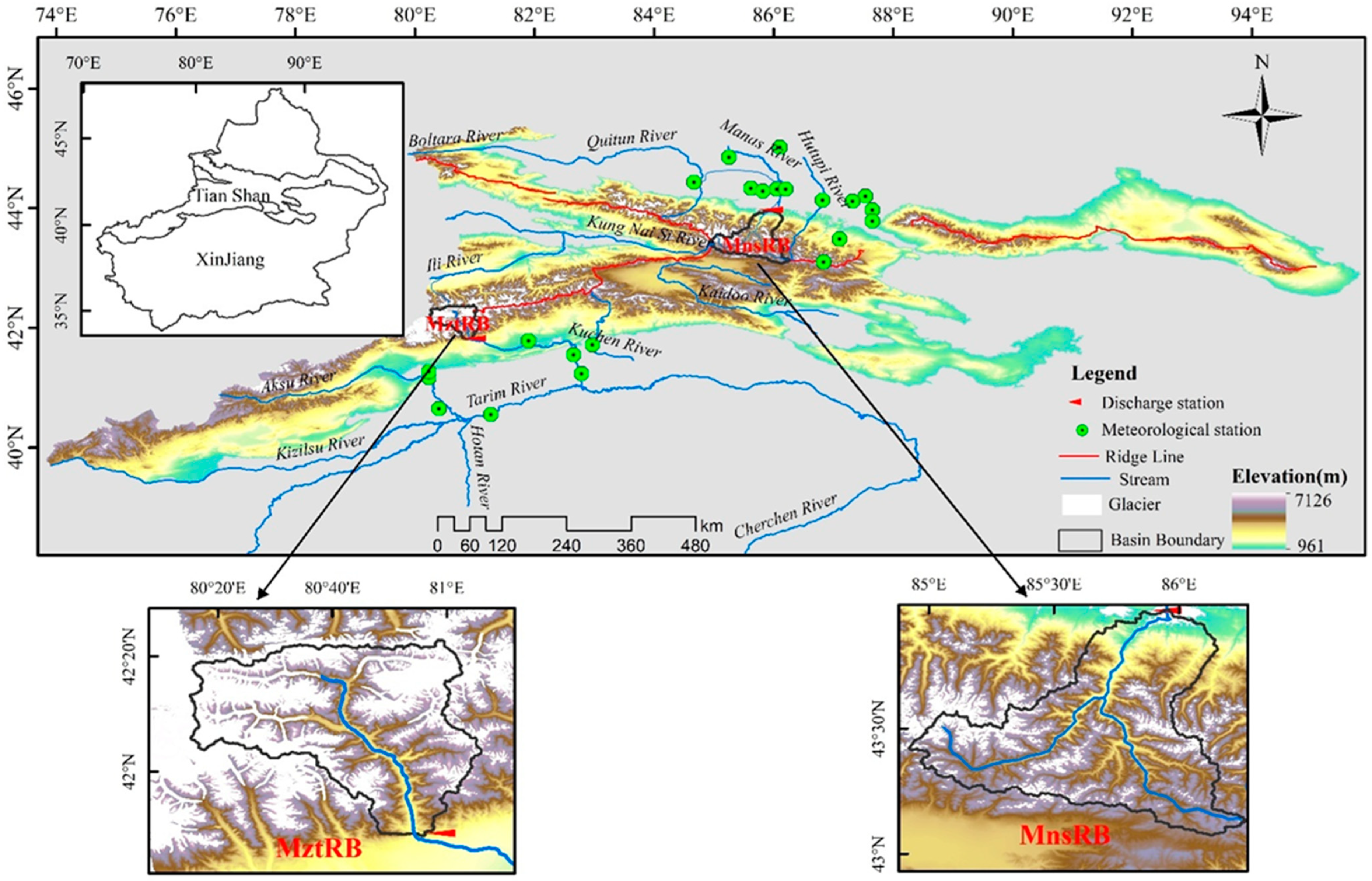

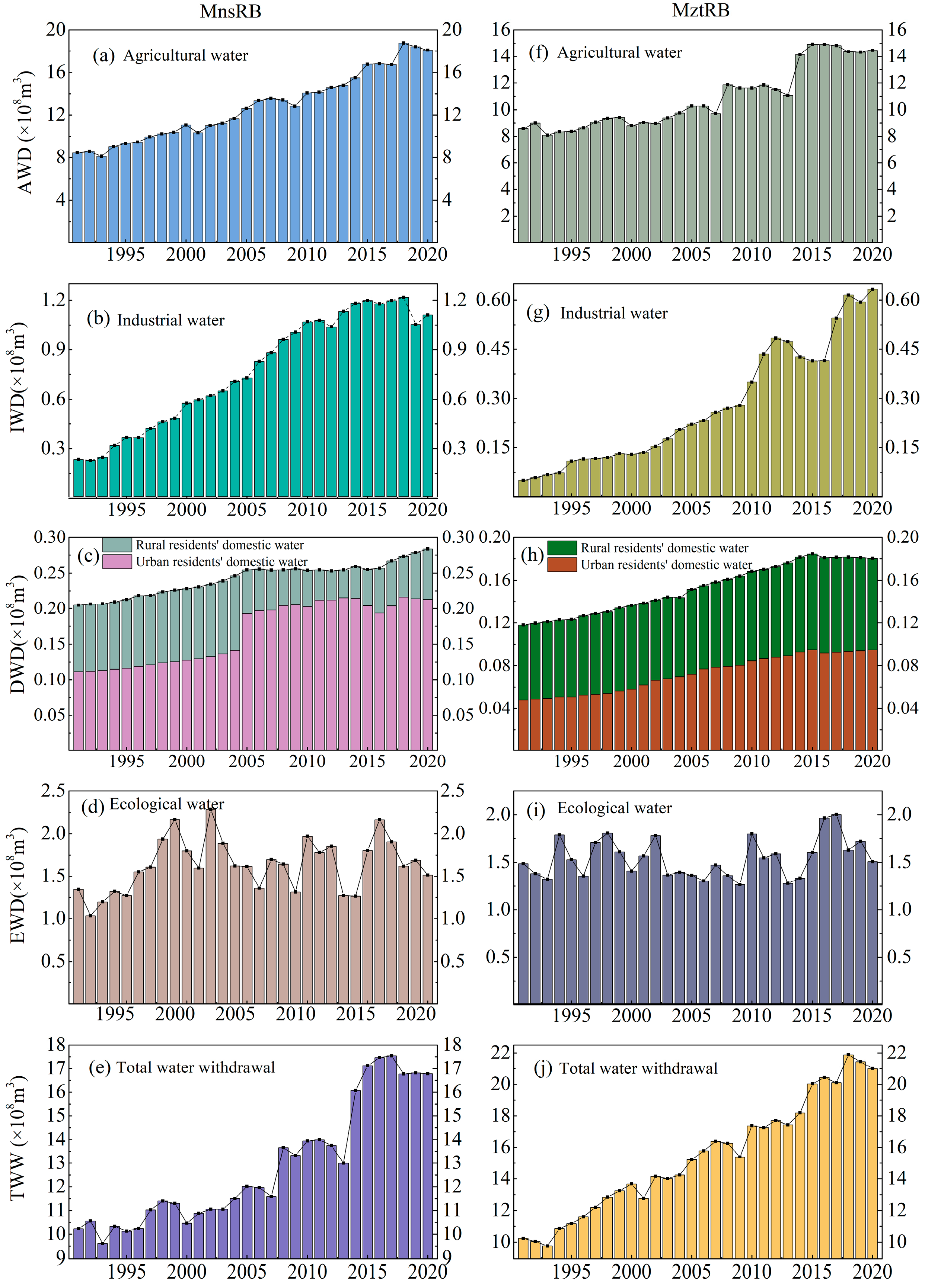
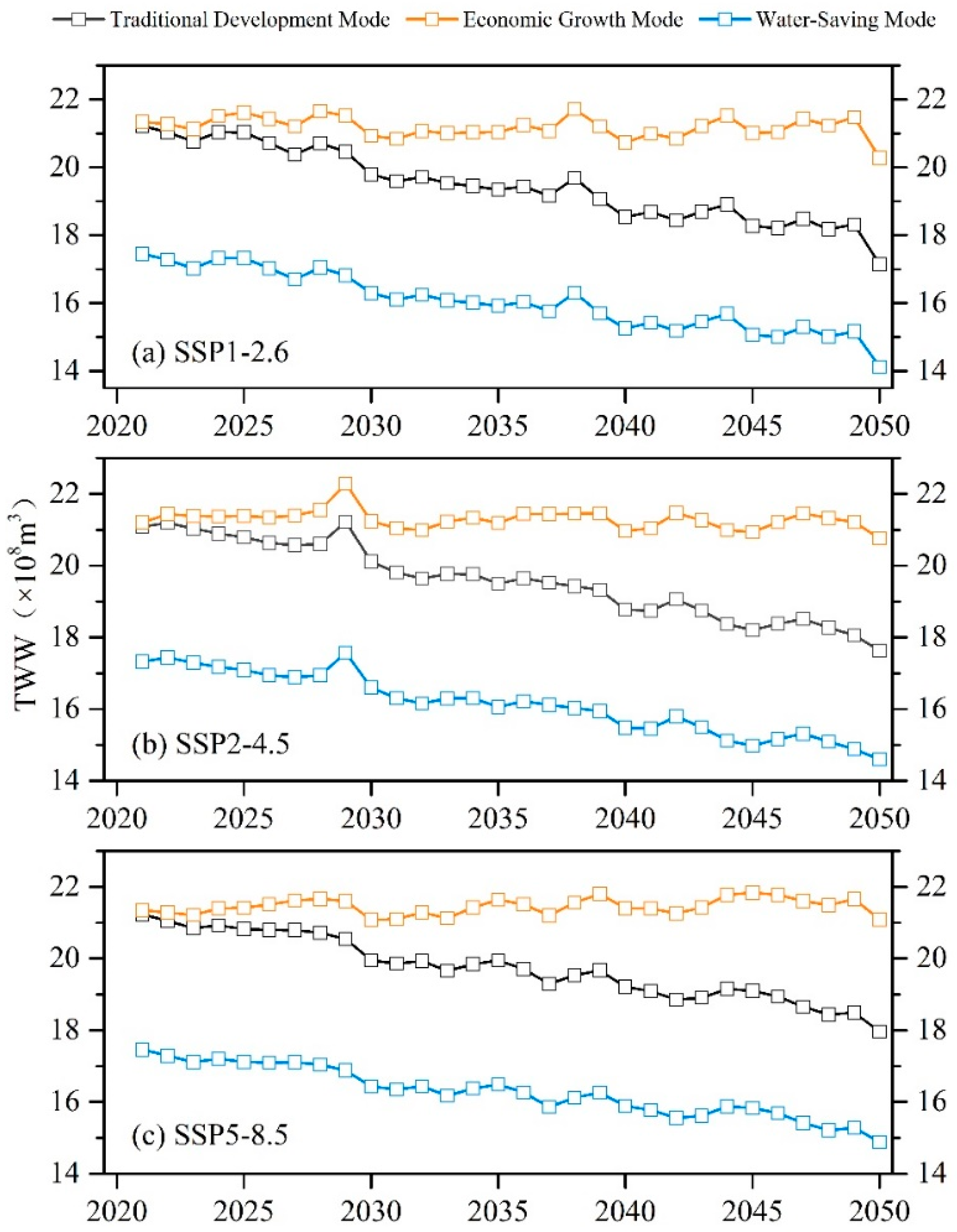
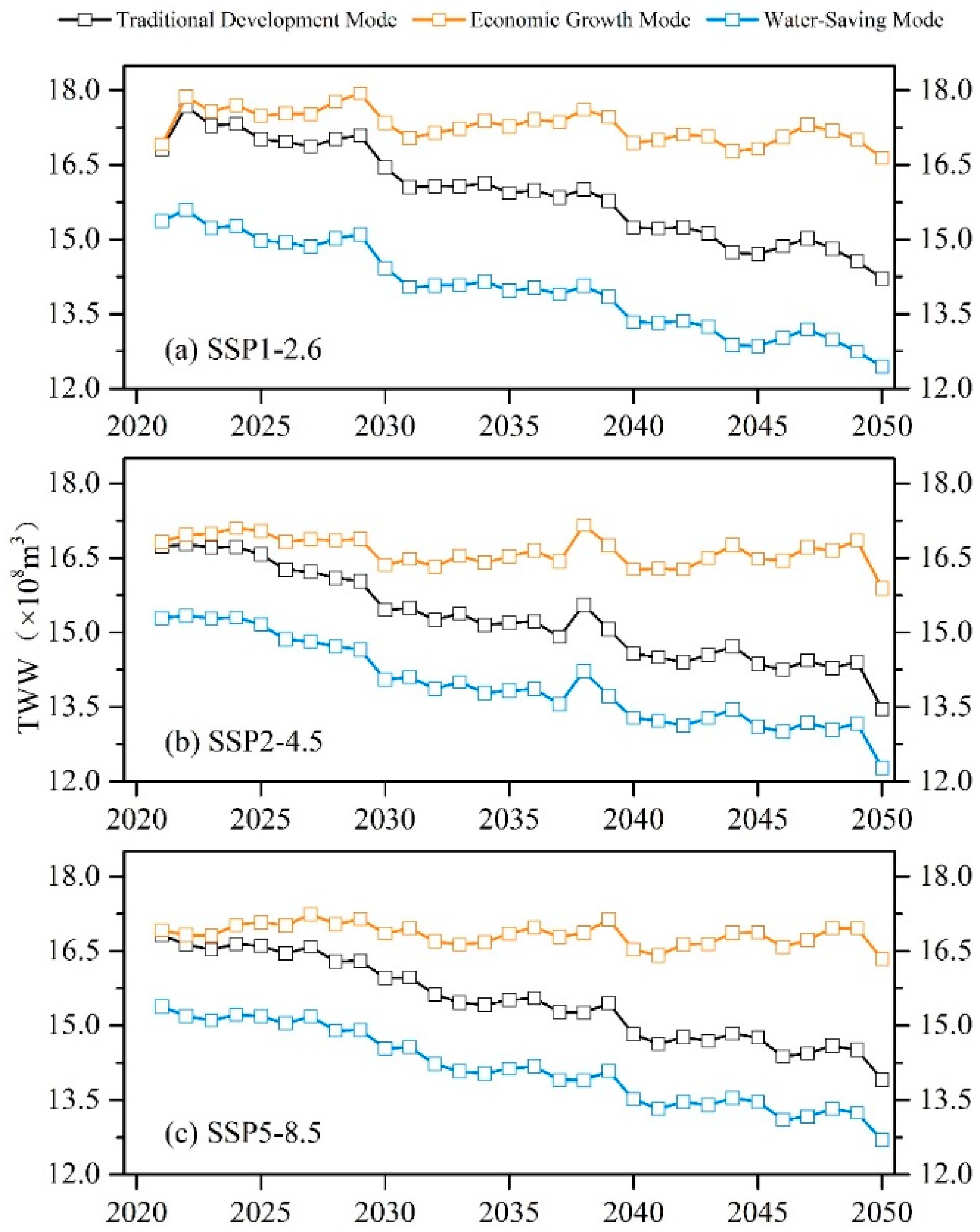


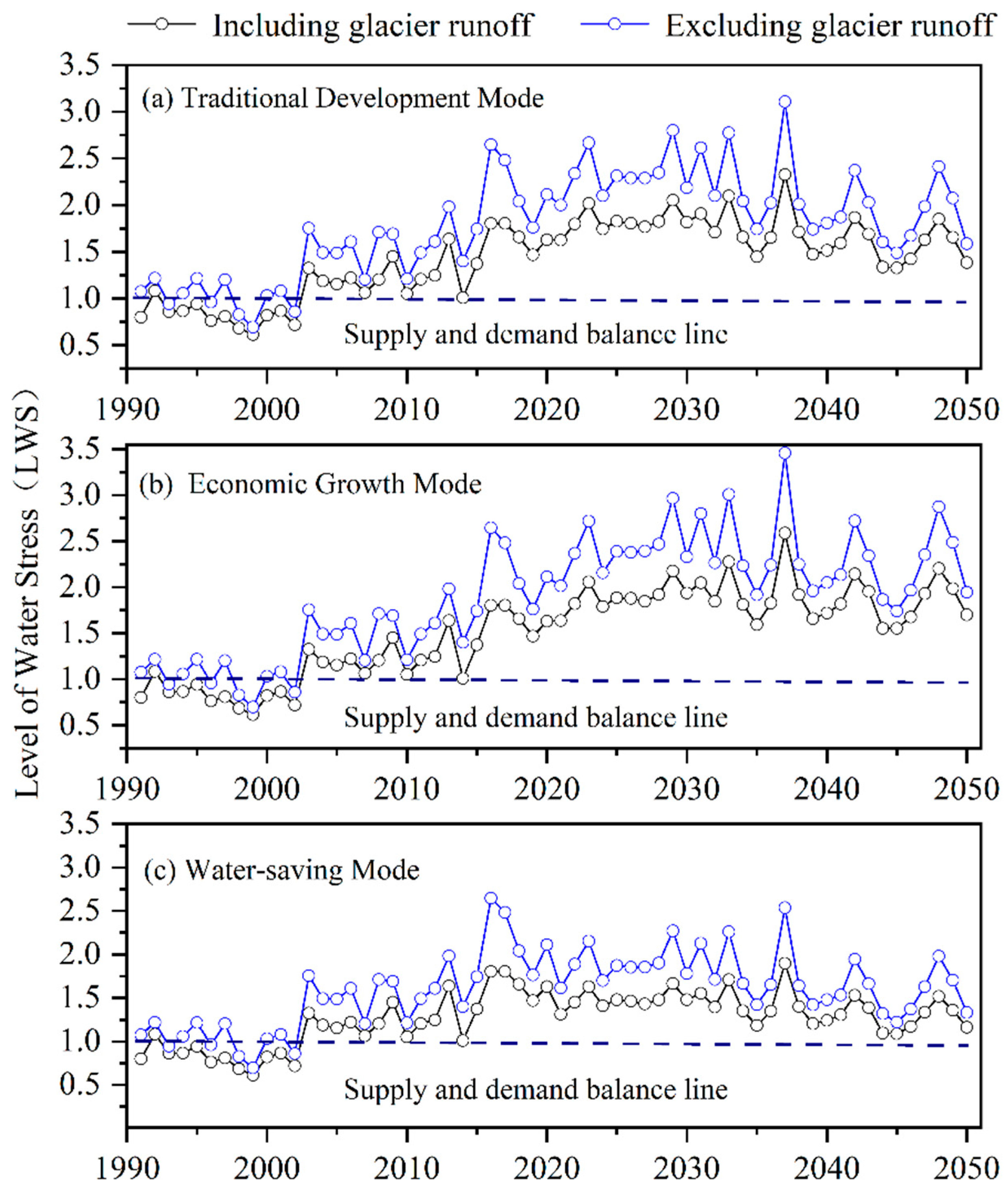
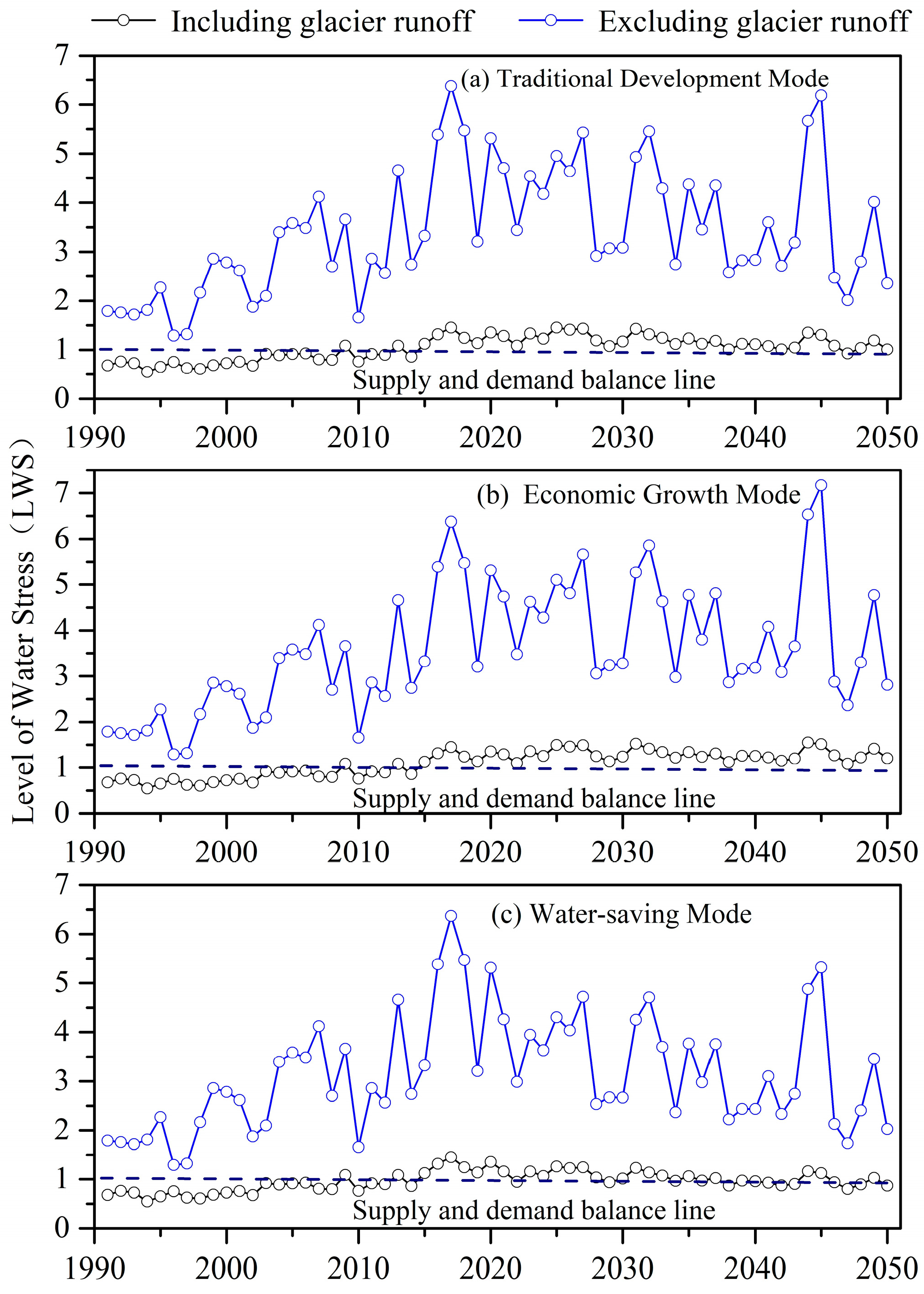
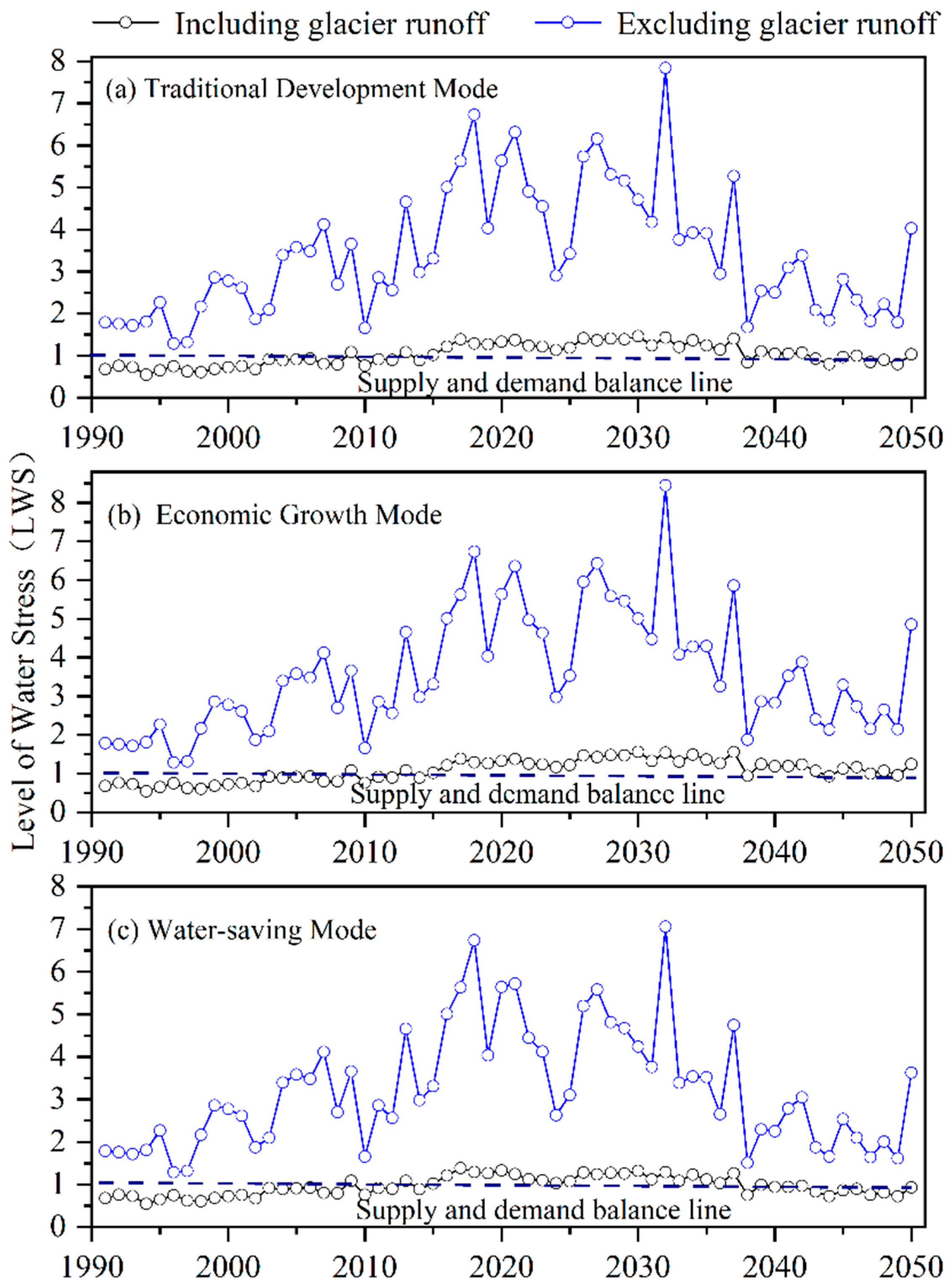

| Data Type | Specific Description | Data Attribute | Main Sources | Time (Year) |
|---|---|---|---|---|
| Meteorological Forcing Data | Observation data from 22 national meteorological stations | Daily precipitation, wind speed, and maximum, minimum, and average temperature | China Meteorological Administration (CMA; http://data.cma.cn) | 1971~2013 |
| Climate Model Data | Generation of GCMs from CMIP6 | Daily precipitation, wind speed, and maximum, minimum, and average temperature | World Climate Research Programme (WCRP) (https://esgf-node.llnl.gov/search/cmip6/ (accessed on 12 September 2022)) | 1971~2100 |
| Glaciers Data | The first and second Chinese Glacier Inventory | Glaciers area | National Scientific Data Centre for Glaciers, Permafrost and Deserts https://www.ncdc.ac.cn/portal/) | / |
| Soil Data | Gridded data of soil classification for the whole world, at a spatial resolution of 5′ | Saturated conductivity, wilting water content, field water-holding capacity, and soil texture | FAO Soil Database (https://www.fao.org/soils-portal/ (accessed on 25 May 2022)) | 2009 |
| Vegetation Data | Global land cover data, at a spatial resolution of 1 km | Monthly average albedo and leaf area index | University of Maryland, USA (https://daac.ornl.gov/) | 2000 |
| Topographic Data | DEM, at a spatial resolution of 30 m | Elevation, slope, aspect, and flow direction | National Earth System Science Data Center (https://www.geodata.cn/) | / |
| Hydrological Observation Data | Kensiwate and Bao chengzi hydrographic stations | Monthly runoff | Xinjiang Hydrological Bureau | 1971~2013 |
| Model Title | Country | Institute | Scenario MIP Ensemble Member | Time Period | Spatical Resolution (lat × lon) |
|---|---|---|---|---|---|
| CMCC-CM2-SR5 | Italy | CMCC | rli1p1f1 | Historical, SSP1, SSP2, SSP5 | 1.25° × 0.94° |
| MIROC6 | Japan | MIROC | rli1p1f1 | Historical, SSP1, SSP2, SSP5 | 1.40° × 1.40° |
| MIROC-ES2L | Japan | MIROC | rli1p1f2 | Historical, SSP1, SSP2, SSP5 | 2.80° × 2.80° |
| NorESM2-LM | Norway | NCC | rli1p1f1 | Historical, SSP1, SSP2, SSP5 | 1.25° × 0.94° |
| CNRM-CM6-1 | France | CNRM | rli1p1f2 | Historical, SSP1, SSP2,SSP5 | 1.40° × 1.40° |
| Basin | Water Demand Indicators | 2020 | 2030 | 2040 | 2050 |
|---|---|---|---|---|---|
| Manas river | Per capita domestic water quota (L/(person × day)) | 100 | 110 | 120 | 130 |
| Water demand per 10,000 CNY of Industrial Value Added (m3/10,000 CNY) | 45 | 39.5 | 33 | 28 | |
| Wheat irrigation water quota (m3/ha) | 3500 | 3350 | 3200 | 3050 | |
| Maize irrigation water quota (m3/ha) | 3675 | 3515 | 3365 | 3215 | |
| Cotton irrigation water quota (m3/ha) | 4200 | 4050 | 3900 | 3750 | |
| Vegetables irrigation water quota (m3/ha) | 3825 | 3675 | 3525 | 3375 | |
| Fruits irrigation water quota (m3/ha) | 4950 | 4800 | 4650 | 4500 | |
| Muzat river | Per capita domestic water demand (L/(person × day)) | 90 | 100 | 110 | 120 |
| Water demand per 10,000 CNY of Industrial Value Added (m3/10,000 CNY) | 65 | 55 | 41 | 35 | |
| Wheat irrigation water quota (m3/ha) | 3750 | 3600 | 3450 | 3300 | |
| Maize irrigation water quota (m3/ha) | 3825 | 3675 | 3525 | 3375 | |
| Cotton irrigation water quota (m3/ha) | 4575 | 4425 | 4275 | 4125 | |
| Vegetables irrigation water quota (m3/ha) | 4425 | 4275 | 4125 | 3975 | |
| Fruits irrigation water quota (m3/ha) | 5100 | 4950 | 4800 | 4650 |
| Water Demand Type | Water Demand Indicator | Value |
|---|---|---|
| Agricultural Water Demand | Crop Irrigation Water Quota | The same as the traditional development mode |
| Growth Rate of Cultivated Land Irrigation Area | With a 20% increase compared to the traditional development mode | |
| Industrial Water Demand | Water Demand per 10,000 CNY of Industrial Value Added | The same as the traditional development mode |
| Domestic Water Demand | Per Capita Domestic Water Demand | The same as the traditional development mode |
| Ecological Water Demand | Growth Rate of Ecological Water | The same as the traditional development mode |
| Water Demand Type | Water Demand Indicator | Value |
|---|---|---|
| Agricultural Water Demand | Crops Irrigation Water Quota | A 20% reduction compared to the traditional development mode |
| Growth Rate of Cultivated Land Irrigation Area | Same as the traditional development mode | |
| Industrial Water Demand | Water demand per 10,000 CNY of industrial value added | A 10% reduction compared to the traditional development mode |
| Domestic Water Demand | Per Capita Domestic Water Demand | A 10% reduction compared to the traditional development mode |
| Ecological Water Demand | Growth Rate of Ecological Water | Same as the traditional development mode |
Disclaimer/Publisher’s Note: The statements, opinions and data contained in all publications are solely those of the individual author(s) and contributor(s) and not of MDPI and/or the editor(s). MDPI and/or the editor(s) disclaim responsibility for any injury to people or property resulting from any ideas, methods, instructions or products referred to in the content. |
© 2025 by the authors. Licensee MDPI, Basel, Switzerland. This article is an open access article distributed under the terms and conditions of the Creative Commons Attribution (CC BY) license (https://creativecommons.org/licenses/by/4.0/).
Share and Cite
He, Q.; Yang, J.; Zhao, Q.; Chen, H.; Wang, Y.; Wang, H.; Wang, X. Assessment of Water Resource Sustainability and Glacier Runoff Impact on the Northern and Southern Slopes of the Tianshan Mountains. Sustainability 2025, 17, 4812. https://doi.org/10.3390/su17114812
He Q, Yang J, Zhao Q, Chen H, Wang Y, Wang H, Wang X. Assessment of Water Resource Sustainability and Glacier Runoff Impact on the Northern and Southern Slopes of the Tianshan Mountains. Sustainability. 2025; 17(11):4812. https://doi.org/10.3390/su17114812
Chicago/Turabian StyleHe, Qingshan, Jianping Yang, Qiudong Zhao, Hongju Chen, Yanxia Wang, Hui Wang, and Xin Wang. 2025. "Assessment of Water Resource Sustainability and Glacier Runoff Impact on the Northern and Southern Slopes of the Tianshan Mountains" Sustainability 17, no. 11: 4812. https://doi.org/10.3390/su17114812
APA StyleHe, Q., Yang, J., Zhao, Q., Chen, H., Wang, Y., Wang, H., & Wang, X. (2025). Assessment of Water Resource Sustainability and Glacier Runoff Impact on the Northern and Southern Slopes of the Tianshan Mountains. Sustainability, 17(11), 4812. https://doi.org/10.3390/su17114812






